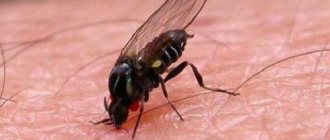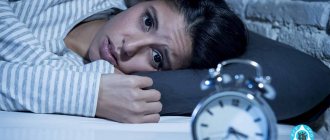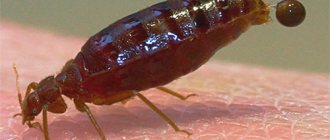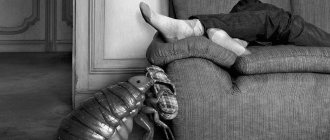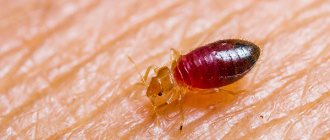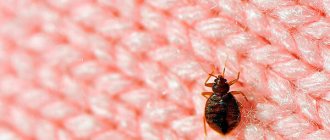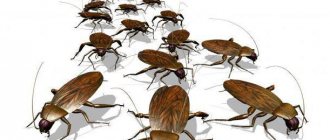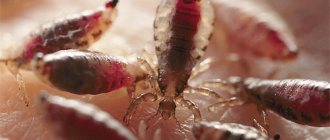Mosquito and mosquito
Flea and its bites
Lice bites
Cockroaches
Degree of bedbug saturation
If a person wakes up in the morning with a feeling of discomfort and finds traces of unknown insect bites on the skin, then the first thought that comes to mind is that this indicates the presence of bedbugs in the house. However, there are many other blood-sucking insects that can bite in bed at night, besides bedbugs. They also leave bite marks on the skin that may look different.
Lovers of human blood
The presence of blood-sucking parasites in an apartment not only gives its residents an unpleasant itchy sensation in the bitten areas, but can also cause sleep disturbances and even nervous disorders.
Interesting!
Statistically, bedbugs are a scourge in some European capitals such as London, Stockholm and Amsterdam, as well as major cities in the United States. The number of apartments in which blood-sucking insects have settled grows exponentially every year, which is why professional bedbug extermination services do not have time to fight them; moreover, the parasites have been able to develop resistance to most insecticides.
In addition to bed bugs, which are the most famous and widespread insects that love to feed on human blood, you can find other similar pests in nature that bite night and day.
Therefore, if someone wakes up in the morning and discovers that he has been bitten by invisible bugs, and he knows for sure that they cannot be in the apartment, then you can try to determine the type of “bloodsucker” by the appearance of the wound at the site of the bite. Below is a list of possible contenders, their descriptions and methods of struggle.
Blood-sucking mosquitoes
Everyone knows for sure what a mosquito looks like. The photo is presented below.
The parasite does not allow you to relax in nature, and voluntarily feels indoors. Females drink blood; they need food to reproduce. And although they live only 1–2 days, they can leave a lot of marks on the body. At the same time, insects have a certain peculiarity in hunting - they become more active at dusk, and become somewhat quiet late at night.
They bite areas of the body that are not covered by clothing. Random bites in the form of red spots and swelling remain on the body. They itch unpleasantly, go away within a day in adults and linger longer on the body of small children. If a person covered himself with a blanket at night, the parasite bites will occur exclusively on open areas of the body. For example, arms, neck, shoulders, upper back.
They don’t fly under the covers or into bed. Photos of mosquito bites are presented below. Another feature of mosquito activity is that they bite everywhere, regardless of where a person is, whether he is sleeping or sitting motionless. Other blood-sucking parasites prefer bed. If a person goes to sleep in another room, bites on the body may not be detected in the morning.
You can notice the presence of mosquitoes in the apartment in the evening. Therefore, you can worry about protective equipment in advance. It’s no secret that an ultrasonic repeller is the best way to get rid of blood-sucking mosquitoes. An effective product appeared on our territory about 15 years ago, and still occupies a leading position among all products against mosquitoes in the apartment. The small box just needs to be plugged into a power outlet and you can sleep peacefully. The squeaking of mosquitoes will be heard, they will fly around the body of a sleeping person, but will not be able to bite. Ultrasound affects the nervous system of the insect, it loses orientation in space and cannot find a power source. Forced to leave the apartment through an open window or crack, or simply dies without being satisfied.
The presence of mosquitoes in an apartment is the least of all blood-sucking parasites. Getting rid of them is much easier and easy to figure out. Bites on the body do not cause any particular inconvenience. To eliminate itching and red spots, use alcohol tinctures, “Zvezdochka” balm, ointment, cream, and gel for insect bites. And in some cases, in the absence of the listed remedies, you can lubricate the affected area of the bite with saliva.
The situation is much more complicated with other blood-sucking insects. Resourcefulness, endurance, patience, and an effective remedy are required.
Mosquitoes and mosquitoes
Mosquito and mosquito
These flying bloodsuckers appear only in the warm season, if there is water or wetland nearby. Mosquitoes are easily recognized by their characteristic buzzing noise at night. Mosquito bites usually itch for several days, then disappear without a trace.
How to get rid of insects in bed?
To get rid of insects in bed:
- Unfold the sofa or bed, take out all the things from the drawers, remove the bedding.
- Carefully inspect each element separately for the presence of insects or traces of vital activity; it is most convenient to do this in daylight and using a flashlight.
- If you find pests, eggs or other signs of presence, take a vacuum cleaner with an empty dust bag and collect them, then remove the bag from the vacuum cleaner and dispose of it immediately.
The frame of a sofa or bed, storage boxes, slatted bottom and other structural parts of the sleeping place can be treated with insecticides in ready-made form against the type of pests that have settled in your home. Tools such as:
- Clean house
- Varan
- Combat SuperSpray
- Super cobra
- Dr. Klaus universal
- August Insecta
- Medilis-Superpower
- Raptor 17 types of insects
- Raid Lavender
- Universal crips
Use any product according to the instructions for its use. When handling, wear closed clothing, rubber gloves and a respirator to protect your respiratory tract.
Carefully!
Do not treat bedding and accessories with insecticides!
To clean bedding or individual items from insects and traces of their presence:
- Place the item in a plastic bag, seal it tightly and place it in the freezer of a refrigerator at a temperature not lower than –15°C for 5–7 days.
- After the specified time has passed, remove the item, shake it over the bathtub, remove insect remains if there are any, and wash as usual.
- After washing, a clean item must be ironed at the maximum permissible temperature for additional disinfection.
Unfortunately, it is not always possible or advisable to clean bedding and accessories.
If the dirt has become ingrained, if possible, throw away the damaged item and replace it with a new one. All these instructions apply specifically to those cases when insects literally live in your bed. If you have established that at night you are bitten by parasites that live not in your bed, but in your room or the entire apartment, it will be necessary to fight them based on their type and lifestyle.
When trying to get rid of insects only in a bed, armchair or chair, remember that this may not be enough to get rid of the problem completely. Even if you manage to destroy insects precisely, there is no guarantee that they are not hiding somewhere else in the room or apartment. If this is the case, and most often this is the case, then some time after disinsection of the bed you will again begin to be bitten at night, because the vacant place of the destroyed insects will be taken by those that lived somewhere nearby. For this reason, it is always advisable to treat the entire apartment.
The fastest, easiest and most effective way to get rid of insects in your bed forever is to order the treatment of the entire apartment at the SES. You will still have to wash and freeze bedding and accessories yourself, but professional treatment will eliminate the likelihood of the problem reoccurring in the future.
Fleas
Flea and its bites
Most often in bed, in addition to bedbugs, ordinary fleas can bite. These jumping bloodsuckers settle indoors where there are pets. Unlike bedbugs, fleas prefer to bite during the day, but this can also happen at night.
Not everyone knows that fleas can carry infections such as typhus, encephalitis, brucellosis, anthrax, etc., so their presence in the apartment is very undesirable.
On a note!
It was the large number of fleas among rats in the Middle Ages that caused the widespread spread of bubonic plague in many European cities, after which about a third of the continent's population died.
Fleas can get into an apartment not only with animals, but also come from a neighbor’s cat or on the clothes of a person who stroked the “poor little kitten” in the yard.
Flea bites are very itchy, and scratching too hard can lead to infection.
To get rid of fleas, you must first treat your pets with special products, and then poison the parasites in your apartment with insecticidal preparations designed to destroy them.
Types of night guests
It is almost impossible to imagine that a person sleeping at home in his bed would be stung by a bee or wasp at night. But there are many other arthropods capable of such “meanness.” If invisible insects bite you at night, it could be:
- bed bugs;
- mosquitoes;
- fleas;
- linen lice;
- midges;
- head lice;
- pubic lice;
- cockroaches.
Each of the listed insects has its own lifestyle, method of attack, and the marks they leave on the body are similar only at first glance.
Bedbugs
Most often, night bites belong to bedbugs. These insects exist at the expense of humans, feeding on their blood. Since parasites are active only at night, they attack people in bed. This is why they are called bed bugs.
Bug
Moreover, they try to settle closer to sleeping places, but constantly and quite quickly multiplying, they occupy more and more new territories. For an adult, one portion of blood is enough for 7–8 days; the larvae feed more often – approximately once every 5 days. Therefore, just having appeared in an apartment, bedbugs do not bite people every day, but as the number of the colony increases, attacks occur every night, and sometimes hungry parasites can even bite pets.
Mosquitoes
A mosquito is one of those insects that often bite people in bed. Unlike bedbugs, darkness is not a prerequisite for a parasite attack; mosquitoes can bite at any time of the day. But it is safer to attack at night, since a sleeping victim does not pose a threat, and you can safely get enough.
Mosquito
Some species of mosquitoes live near people because females require protein, which they receive in the blood, to reproduce.
If these bloodsuckers attack a person at night, the bites are found on open areas of the body.
Midges
If dark midges fly indoors during the day, then the question of who bites in bed at night can be taken off the agenda. It is these small insects that leave painful wounds on the body by gnawing off a piece of skin. Insect bites can cause a severe allergic reaction, accompanied by severe redness and swelling.
Midges
Fleas
Among the blood-sucking insects that may end up in bed, fleas occupy a special place. In human homes, you can find several varieties of these insects, for example, bed, human, dog or cat.
At night, people are most often bitten by bed or human fleas, but attacks by other species are also possible. Flea bites are very painful and can cause a person to wake up. This is due to the fact that, unlike, for example, bedbugs or mosquitoes, the saliva of these parasites does not contain painkillers.
Flea
Head and pubic lice
Lice are ectoparasites of those that bite in bed at night other than bedbugs. These insects parasitize a person, constantly being on his body, so they can be active at any time of the day, including when the victim is sleeping. At first, it is not easy to detect parasites, but they actively feed and multiply quickly. Very soon their presence becomes obvious, as they cause a lot of unpleasant sensations to the owner.
Louse
Linen lice
At night, a person can be bitten by linen lice in their bed. This is a subspecies of head lice, but it is much less common. Unlike their closest relatives, these parasites do not live on the human body permanently. They settle in the folds and seams of bed linen, clothing, sometimes in pillows and mattresses, and at night they attack sleeping people to feed on their blood.
This type of lice can appear in any home, so you need to carefully monitor cleanliness and regularly wash your clothes at high temperatures.
Cockroaches
Surprisingly, cockroaches sometimes bite humans. This happens when there are too many insects and they no longer have enough food. Most often, baleen arthropods gnaw soft tissues, for example, the skin on the neck and earlobes. But sometimes they can bite your arms or legs.
Cockroach
In addition, cockroaches can attack humans in search of water. In this case, they drink saliva that accumulates in the corners of the mouth, or discharge from the eyes.
Lice
Lice bites
A rather unpleasant answer to the question of what bites someone in bed at night may be lice that do not live in the bed itself, but settle in clothing or hairy parts of the body. Lice bites are smaller in size than those left by bedbugs, but they can be larger in number, as a result of which they cause discomfort.
The most common head lice bite people on the head in the neck, temples and above the ears, so traces of their bites can be found on the skin under the hair.
Linen lice
Lice, after getting on the bedding, begin to lay nit eggs, which are completely invisible to humans. They take about twenty days to mature after they are laid.
As time passes, lice begin to torment the owner of the sleeping place; they bite, leaving characteristic marks. Traces remain in the locations of the blood vessels; the louse does not crawl onto the head.
This problem must be dealt with thoroughly, since the louse will not disappear on its own. She does not die of hunger in the absence of the owners of the house, but goes into another stage of development, into waiting.
Since insects live in bed, it is necessary to combat them through general cleaning of bedding.
The bedding set is boiled and then steamed using an iron. Particular attention should be paid to folds in the material and seams.
It is imperative to treat the mattress with a specialized spray, which can be purchased at a pharmacy. A general cleaning, cleaning pillows and blankets won’t hurt either.
It is advisable to add a little ammonia or vinegar to the water for washing floors. In winter, pillows and blankets are taken out into the cold or in the summer into the soaring sun - this will help kill all the nits.
Pay attention to the bed frame, it needs to be covered with insect chalk. The mattress is additionally treated with lavender oil - it gives a pleasant smell and blocks the proliferation of lice.
Cockroaches
Cockroaches
This option may surprise you, but the “red and mustachioed” ones are quite capable of biting a sleeping person. The human epidermis on the face near the nose or lips is quite suitable for them as food. Typically, cockroaches bite when there is a lack of water and food, when their number in the apartment is so large that they begin to look for other types of food.
You can get rid of cockroaches only by completely destroying the entire colony in the apartment.
Can a cockroach bite at night?
It is unlikely that a cockroach will attack a person. For him, it is much more interesting how many crumbs and leftovers of other food are in the kitchen. Only in some cases, when their population has increased incredibly or there is not enough water, they can crawl into bed and gnaw the surface of the skin of the lips or near the nose. By the way, in dormitories such cases occur more often. For some reason, cockroaches are especially attracted to children. Apparently because the skin is more delicate.
As you can see, these insects do not suck our blood and their bites are not at all like flea or bedbug bites.
Be that as it may, the bite site of any of the above-mentioned insects should be treated. To reduce your itching risk of contracting a disease:
- Wash the bite area with soap
- Treat with alcohol, propolis or calendula tincture
- Apply gel like Fenistil.
But only if after a bite a person experiences an undesirable reaction (headache, fever, strange rashes), you should not hesitate and consult a doctor. Allergies to bites can be different for everyone. And even if the symptoms are not too severe now, things may become more serious in the future.
Comparison of various insects and their bites
The easiest way to detect an insect that bites in your bed at night is to catch it and examine it, which not everyone succeeds in, but is quite possible.
In order to determine accurately, just look at photographs of various parasites that love to bite and drink human blood. Everyone knows what mosquitoes look like, but fleas are very difficult to catch.
The photo of blood-sucking bugs shows their rounded shape and changes in size depending on the state of saturation with blood. Bedbug bites have a characteristic feature: they are located on the skin in a path a few centimeters apart. With a large number of them, especially in children, an allergic reaction is often observed, anemia may develop, and when scratching with severe itching, a purulent-inflammatory process may begin in the wound.
How to fight fleas
This is interesting
Fleas and their hosts, rats, caused the spread of plague in the Middle Ages, as a result of which almost a third of Europe died out.
Their bites are incredibly similar to bedbug bites and can also be in the form of a chain. It is not difficult to notice fleas on light-colored underwear, but catching them is not so easy. They jump quickly, and not every person can react.
They should be destroyed in two steps: first from the spreading animal, then throughout the entire premises.
To poison fleas indoors, you need to use the same means as for bedbugs, but a veterinarian will recommend a remedy for your pet.
Carpet beetle in upholstered furniture
There are different types of carpet beetles; there are 4 variants of the most common varieties that could live in sofas:
- Carpet beetles with a 2-4 mm body of a rich brown uniform color . Feature: adult individuals feed on the subcutaneous “fat” that they accumulated in the larval stage, and the larvae themselves eat carpets.
- Ham . They have body sizes of up to 7-9.5 mm and are two-colored – yellowish-gray and brown . Feature: the beetle reproduces too quickly.
- Fur coats . Little black bugs with a body length of 4-6 mm, on the backs of which there are always 5 white dots . Feature: they love to live in sofas with fur upholstery.
- House or museum . The length of the bodies of such beetles reaches 5-6 mm on average, they are brown and like to live not only in sofas, but also in flower pots , thereby damaging plants. Feature: you rarely see them in a house or apartment, but their appearance cannot be ruled out.
It should be noted that if the bug does not feed on sofa fabrics or leather upholstery, then it may well simply live there, feeding on something else. This beetle usually feeds:
- cardboard;
- fibers from old fabrics;
- old loose wood;
- glue;
- carpets;
- cat or dog hair;
- food products - cereals, for example, or bread crumbs;
- and, of course, skin.
- Frequent vacuuming . Use a vacuum cleaner twice a day in areas where beetles are found. And do this for a week or 10 days.
- Spray the sofa with some insecticide to kill these pests.
- Use different temperatures and sudden changes when cleaning the sofa. Beetles don’t like this very much; they may even die if the room is ventilated sharply for several hours in winter.
- Use a steam generator with a chemical that kills bugs and their larvae.
- Use powders, tablets, traps and other devices as additives.
Let's take a look at a couple of drugs that you can safely use to get rid of skin beetles in your sofa.
Skin beetle:
Do cockroaches bite at night?
Cockroaches rarely bite humans. They are inhabitants of kitchens, feeding on crumbs from the table and leftover food in trash cans. Only with very abundant reproduction and a lack of water can they crawl onto the bed and gnaw the epidermis around the lips and nose of people. Today, similar situations sometimes occur in hostels.
Of course, cockroaches are not blood-sucking insects, so even if they bite, it’s completely different from the way fleas or bed bugs do.
In any case, if you are bitten by insects, their bites should be treated to reduce itching and prevent infection:
- bite sites are washed with soapy water
- the most painful bites are wiped with alcohol or alcohol tincture of calendula or propolis
- Itching from bites can be reduced with Fenistil gel.
But if, after being bitten by blood-sucking insects, the temperature begins to rise and a characteristic rash appears on the skin, it is advisable to show the person to a doctor. An allergy to bites can have serious consequences, and even if at a particular moment it does not manifest itself very strongly, in the future the reaction to bites can be extremely acute.
The most modern, stylish apartment is not protected from insects. Small crawling, flying individuals do not pay attention to the degree of grooming or the design of the home. Penetrating in different ways, they can cause a lot of problems for the owner, especially if they choose a sofa as their habitat. In this article, we suggest finding out what can grow in upholstered furniture, and we will also tell you about the ways that insects can enter the apartment.
Lice: the parasites that are always around
Lice in bed are quite rare. For these insects, falling from the hair or body of a person is fatal - they are slow and rarely able to climb back (at the same time, they vitally need to feed on blood very often). Lice cannot be called typical bed blood-sucking insects.
Lice spend their entire lives on the head (head lice) or other hairy parts of a person (pubic lice). There are also linen lice that live in clothes, but today they are found only among tramps who very rarely change their clothes and never wash them.
Lice bites are usually less noticeable and less painful than flea or bedbug bites, but because they are so numerous, they can also be quite itchy.
The photo shows nits in a child’s hair (lice eggs):
